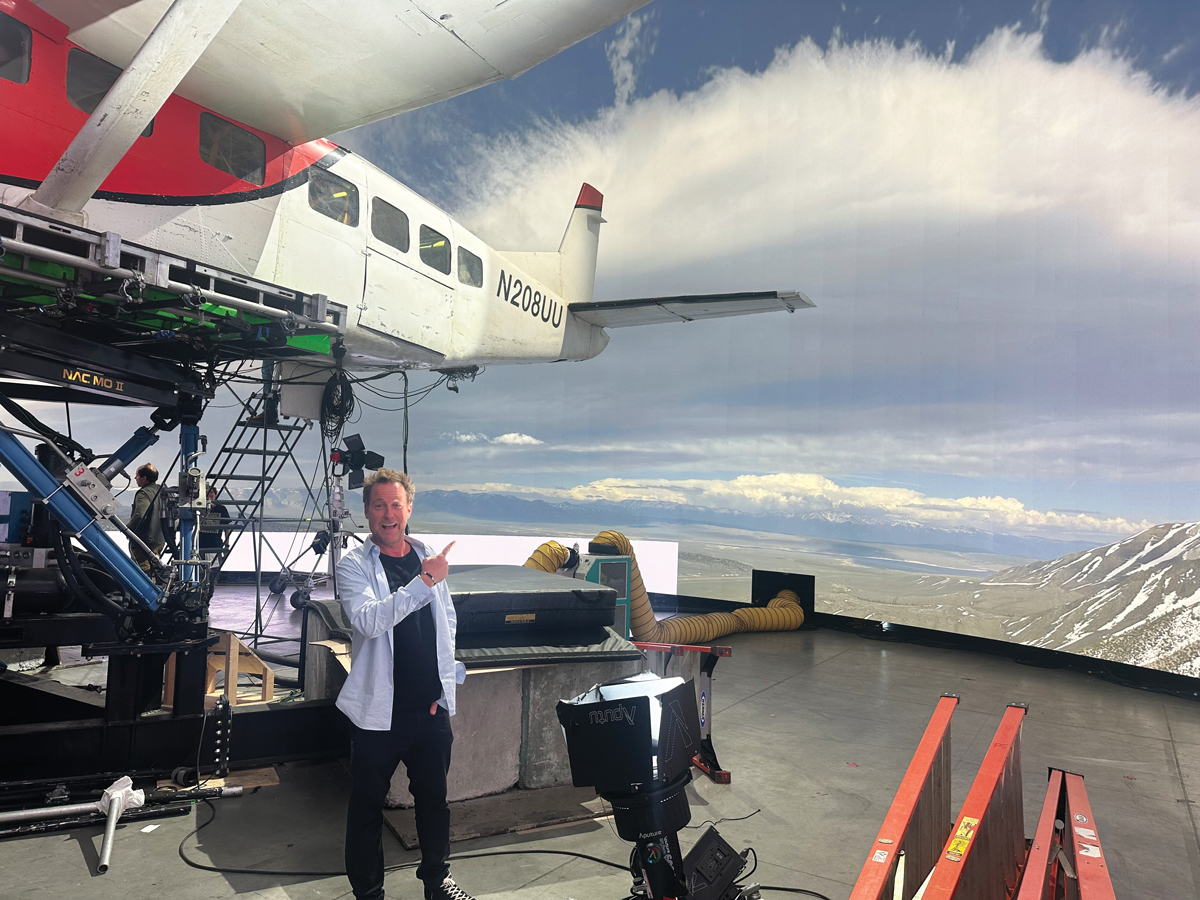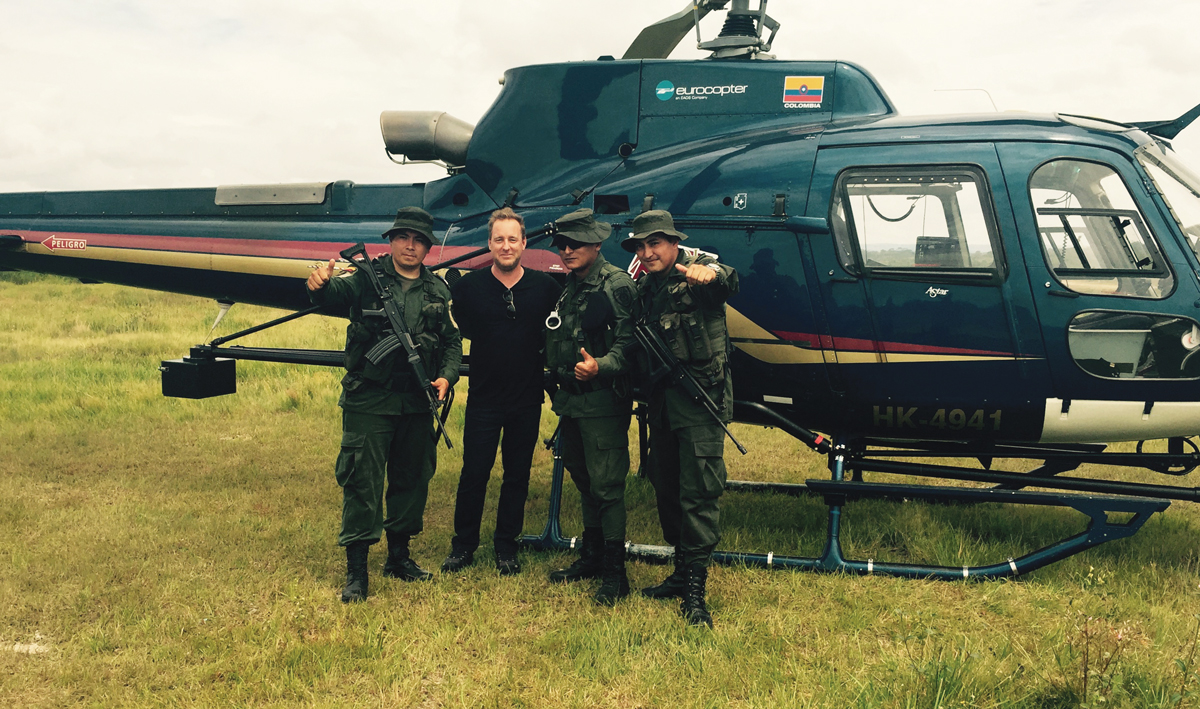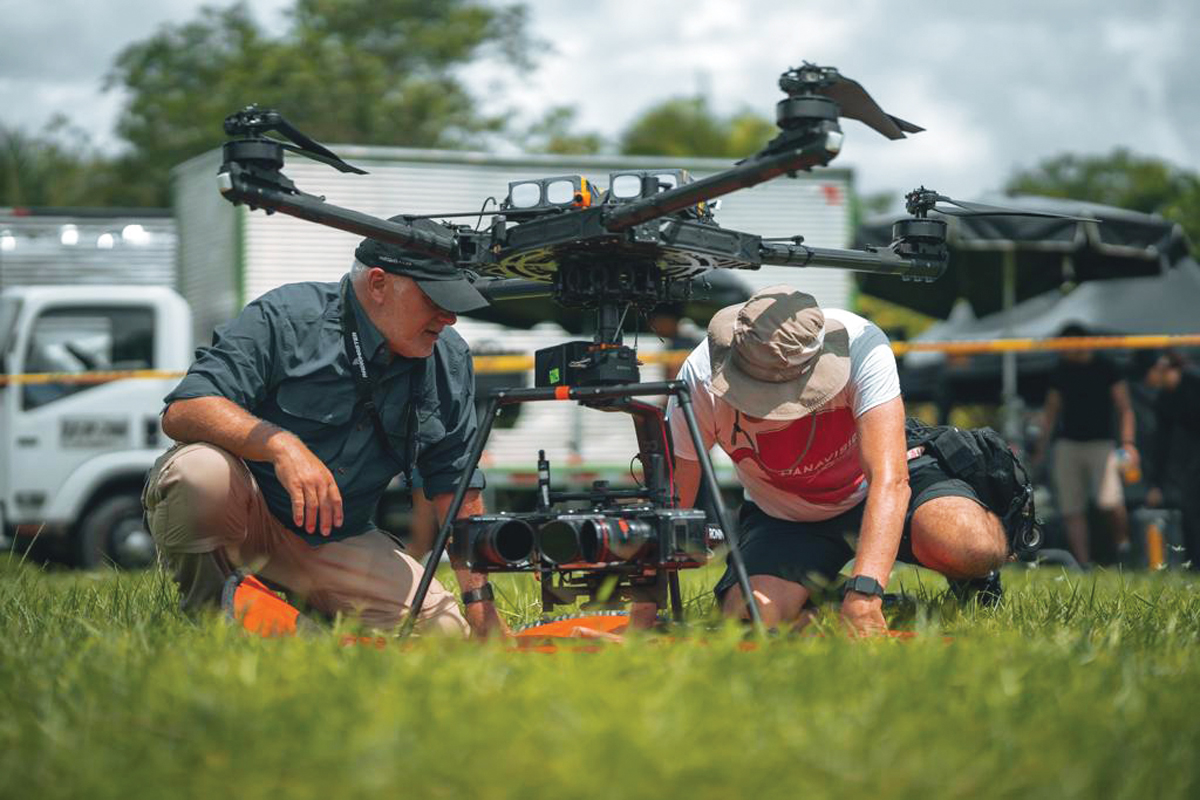
The High Life: Aerial DOPs
Posted on Jul 25, 2024 by Samara Husbands
Definition explores the world of aerial cinematography through the lens of three high-flying DOPs
Dylan Goss
His first aerial credit was for Bad Boys, the original 1995 hit. Nearly 30 years on, Dylan Goss is one of a handful of go-to aerial cinematographers in the business.
Name a blockbuster and you have probably seen his work. Among them are The Game, Titanic, Kundun, Pushing Tin, Up in the Air, Fast & Furious 6, Elysium, San Andreas, Independence Day: Resurgence, Skyscraper, American Made, Avengers: Infinity War, First Man, Black Panther: Wakanda Forever, Free Guy and, just this year, The Fall Guy and Civil War.
He has also shot aerials on shows you may not associate with sweeping vistas, like the Oscar-winning Crash and Funny Games, and considers himself equal parts technician and photographer.
“I grew up wanting to code computers and solder electronics. Back then, there weren’t YouTube videos telling you how to do it. I enjoyed figuring it out myself. So now, when we have to come up with solutions and custom integrations, I feel pretty comfortable doing that.”
On a new untitled Paul Thomas Anderson feature, Goss had to adapt a gimbal to fit large 35mm VistaVision cameras which were never designed for aerial work.
“Even though they are supposed to be mimicking digital news footage coming from a helicopter, so they could easily have shot digital, they were adamant about using VistaVision. We built this crazy rig to put an awkward camera inside that gimbal.”
On another recent project, he helped design a 360 rig fit with six RED V-RAPTORs to capture shots to be used on a volume built by Lux Machina.
“We took the existing gimbal design, worked out the geometry of the lenses and how they would work in sideways or portrait mode, and helped them understand the challenges of putting this on a helicopter.
“You just learn how things work in an aircraft. Although there are remote-control options, everything needs to be wired and needs to be redundant. You are in a real flight environment, and when you start working with a product that was not made for that scenario, you have to make some adjustments.”
Equipment used to be so specialised that Goss was once flown out to Australia for just one day to shoot a commercial, purely because there was no such kit or crew in the country.
Kit now is more solid-state electronics, with fewer moving parts, and designed to be bulletproof. “In the old days, you had to keep returning to the factory and to take the gimbal apart. It was like watch mechanics inside and my job was to keep it all ticking.”
While the gear has evolved from Spacecam to WESCAM, from Eclipse to Shotover – and propagated worldwide – Goss is still in high demand even if the gear, pilots, helicopters or special Phenom jets command a premium.
“Generally, I’m given a brief and they trust me to deliver. The production has to have confidence that we’re going to execute the brief because shooting from a heli still has a high-dollar value.
“Some jobs don’t have the money, so they adjust their creative and shoot drones. There’s always a way to re-engineer something. You could use a stepladder or a crane, but the projects I’m hired for are the big movies that want the big shots done their way.”
For bigger-scope shots, “it makes sense to fly an aircraft over big spaces with arcs and large movements for the momentum you can’t get with a drone.”
Top Gun: Maverick raised the bar – but few films have the access or budget to be made with the assistance of the US Navy. Even forthcoming Apple TV+ feature Mayday, in which Ryan Reynolds plays a jet pilot, was largely shot from helicopters aerially directed by Goss.
Increasingly, he will work with the VFX supervisor to capture aerial plates. This will involve arrays of cameras configured to capture vast panoramas at high resolution for stitching in post. He finds previs shots a little exhausting because all the shots have been figured out, broken down and budgeted for.
“There’s not a lot of room to expand. If I’m sent out to do three shots, I can’t come back and be like, ‘Guess what? I shot an extra 20 hours of helicopter time – and here’s the bill!’” he says.
“You have to stick to the brief. But we do find moments where you shoot extra material and you’re wondering if that’s going to get recognised by a director or editor. I can sometimes come back with hours of footage that will never see the light of day.”
He enjoys working with directors such as Denis Villeneuve, Alex Garland and Doug Liman, VFX supervisor Paul Lambert and DOPs like Roger Deakins, who desire to do as much in camera as possible.
In Sicario, he was tracking a convoy of FBI jeeps where the heli work had to look like it was shot from a Reaper drone. For the aerial shots of a border crossing, Villeneuve flew with Goss in a heli at dawn down to El Paso.
“When we got to the border, it was a beautiful, magical sunrise, one where you couldn’t help but start pointing the camera around. Denis and I are in the back seat of the heli, I look over and he gives me a thumbs up to start rolling.
“I shot a lot of footage for that movie; it was amazing to see it in the final film.”
Working with Villeneuve again on Dune, Goss found even more of his work in the final cut.
“We’re sitting on top of a cliff looking over the Wadi Rum with a camera and tripod just surveying the immense scale of the landscape. They used it because it served the story.
“I have lots of obvious aerial action shots from a heli I could quote, but I am awed by being given the opportunity to create with filmmakers of his and Roger Deakins’ calibre.”
The ornithopter sequences in Dune and Dune: Part 2 included shots filmed by Goss from a helicopter in Jordan’s Wadi Rum of a different helicopter that suited the scale of the fictional vehicle.
“It’s a stand-in for the ornithopter. So while I’m filming an empty frame for a big superhero movie [he has shot sequences for Spider-Man: Homecoming, Guardians of the Galaxy Vol 2 as well as Avengers: Endgame] into which they will insert VFX, for Denis I’m shooting more practical FX.
“The tracking of my frame is real, the light on the object is authentic. If it lands or takes off from the desert floor then all these interactions with sand and light add to the plausibility of the final picture.”
On the set of forthcoming feature The Instigators, Liman told Goss about his long-gestating project to film Tom Cruise aboard the International Space Station.
“Doug [Liman] is a problem-solver and explained that they needed to redesign the camera by removing components which weren’t designed for zero gravity. They were taking an existing camera and space-proofing it. Sign me up!
“My understanding is that, if they go at all, it will be Doug and Tom plus a camera since the cost for seats is astronomical.
“If you are on the ISS, audiences can really feel that you’re there. The way the light comes through a window, or the way your arms float would be tricky to simulate even on the most cutting-edge sound stage.”
John Marzano
Renowned aerial DOP John Marzano chats sky-high cinematography, the aircraft involved and memorable career moments
Based in the UK but a ‘world leader in the field of aerial cinematography’, Marzano Films – headed up by seasoned DOP John Marzano – blends deep, hands-on filmmaking knowledge with a complete aerial production package. With credits spanning more than 150 award-winning features, docs, series and commercials – including House of the Dragon, The Crown, 1917, Zero Dark Thirty and Harry Potter and the Prisoner of Azkaban – the truly extensive portfolio of Marzano Films speaks for itself.
Marzano first began as a camera trainee, “learning the craft from the ground up,” he says. “In 1989, while operating for the second unit on a feature film called When The Whales Came, I was required to set up the camera in the helicopter for some aerial shots,” he recalls. Cultivating a real knack for airborne operation, subsequently his work ‘shifted gradually from ground-based to aerial cinematography.’
Ready for take-off
After acting as operator on low-budget projects, Marzano stepped into more mainstream features like The World Is Not Enough, signalling the start of a long relationship with the 007 franchise. “I am proud to have shot the aerials for the last eight Bond films,” he states. “For Daniel Craig’s last appearance as 007 in No Time to Die, we shot both IMAX and 35mm scenes with the Eclipse system in Jamaica, Norway, Italy and the UK.”
With global shoots come local aviation laws – “not just for helicopter or aeroplane work, but also for drone work,” explains Marzano. Licensed to operate almost anywhere in the world, Marzano Films trains its team in ‘the intricacies of working around aircraft’ and maintains an ‘unblemished aerial record’.
An equipment specialist as well as a creative cohort, Marzano Films “employs a host of helicopter-mounted systems,” begins Marzano, “but our Eclipse gimbal, with its military-grade gyro-stabilisation technology, is the most flexible aerial system currently available, capable of housing anything from a small Sony VENICE 2 right up to an IMAX camera or even our six-camera array.” The team also developed the mini Eclipse – like the Eclipse system, but more compact and lightweight – as well as the First-Person View Hybrid drone (used on The Meg 2, Fast and Furious and The Lord of The Rings: The Rings of Power), a three-camera array system (Wonka) and a drone specifically designed to house an ARRIFLEX 235 (Saltburn).
In the industry for over 30 years, since the ‘early days of sitting with legs hanging out of the helicopter’s open side door’, Marzano has had a first-hand view of the transformation, noting how drones permanently changed aerial filming.
“I’ve been utilising drones for aerial filming for several years and I’m amazed at how quickly the genre has developed,” he admits, having stocked Marzano Films with an ‘extensive inventory of the latest drone aircraft’.
To keep the industry abreast of the latest aerial gadgets, Marzano Films collaborates with major retailers, ensuring new releases integrate with helicopter and drone gimbals. It recently did just this with the Sony BURANO, which James Friend ASC, BSC used on The Wingman.
Marzano Films also nurtures fresh talent, feeling “a duty to impart the skills we’ve developed over the years to young film enthusiasts,” says Marzano. “We’ve started a programme to teach drone pilots how to fly for film and train new aerial operators in the art of filmmaking.”
Looking back, looking up
Throughout his career, Marzano has worked with some ‘extremely illustrious directors’, he admits, such as Steven Spielberg, Sam Mendes, JJ Abrams and Ridley Scott. “Black Hawk Down will always be a standout experience for me,” he shares. “As the aerial DOP on the film, I was given two camera helicopters, four US Army Black Hawk helicopters and four Little Bird attack helicopters to play with and an instruction from Ridley to ‘go shoot me some great shit!’ – a challenge the aerial team relished,” he recalls fondly. “I’m so proud of the aerial cinematography, which played a significant part in the final edit, and enjoyed every minute.
“At the opposite end of the spectrum,” Marzano continues, “my drone team and I faced some exhausting challenges, riding boats down fast-flowing rapids and carrying drones on long hikes in the jungles of Columbia just to get an amazing shot for Paddington In Peru,” which hits cinemas in November. “I’m excited to see the fruits of my teams hard work on the big screen.”
Jeremy Braben
Aerial DOP Jeremy Braben elevates productions to new heights with help from his team at Helicopter Film Services
Words Katie Kasperson
Like many in the film industry, Jeremy Braben grew up with a camera always in hand. His parents – both artists – nudged him towards a creative career, yet Braben had another calling: aviation.
Documentary making, early jobs in current affairs, TV production and music videos allowed Braben the ‘occasional use of a helicopter’, he highlights. This ‘further whetted the aerial appetite’ – especially filming news segments and live concerts such as Michael Jackson’s Bad tour. After around a decade, he combined his two passions and ‘made the decision to focus solely as an aerial cinematographer’, forming Helicopter Film Services (HFS) in 1993.
Industry established
With over three decades under its belt, HFS offers aerial filming services to features, scripted and unscripted television, commercials and branded content via helicopters, jets, drones and stabilised camera systems. Although based in north-west London, the firm enjoys worldwide operations – having travelled to Greece (Glass Onion: A Knives Out Mystery, The Bourne Identity) and Spain (House of the Dragon), as well as Japan, Iceland, Africa, Hawaii and an abundance of other destinations.
Braben himself has served as aerial DOP on over 150 productions, including Wicked, Sonic the Hedgehog 3, The Union and How to Train Your Dragon most recently. On the latter, he shot from both helicopter and drone, filming on a studio lot and on location in four countries.
Over the years, Braben and his team at HFS have worked alongside directors Steven Spielberg, Ridley Scott and James Cameron – Braben’s first big break was aerial operating on Titanic – as well as actors like Matt Damon, George Clooney, Gary Oldman and Harrison Ford. They even helped Spielberg with his first-ever drone project, filming the stacks sequences in Ready Player One.
Today’s tech
Aerial cinematography today ‘is split into two areas’, according to Braben: helicopter/aeroplane and drone. When filming from a helicopter or aeroplane, “it’s generally a SHOTOVER six-axis gimbal – either the F1 or the larger K1,” details Braben. “The latter system incorporates specially designed housings for multicamera aerial arrays,” he adds, having devised the Typhon six-camera array in 2017.
Over HFS’s lifespan, aerial filming has witnessed quite the technological transformation. “Not so long ago,” begins Braben, “there were only a handful of big, expensive gimbals from WESCAM and Spacecam for shooting mostly 35mm film. As digital technology evolved out of the military and found its way into smaller, lighter and cheaper gimbals, the market exploded.
“Since contemporary camera bodies have bigger sensors but are smaller physically,” he continues, “we’ve seen the development of the multicamera arrays and POV cameras in cockpits and on wings.” Braben also notes the ‘welcome return’ of 65mm IMAX film, famously used on Christopher Nolan’s Oppenheimer.
On the other hand, “drones have seen a veritable explosion of close-distance aerial filming,” Braben explains. Responding to DOP demand, he created the TITAN, an ultra-heavy lift drone which supports large format filming on digital or 35mm. “Helicopter Film Services’ heritage – combined with our adoption of new technology – enables us to stay ahead,” Braben summarises.
Team effort
While aerial filming requires a certain level of niche expertise, it’s a creative endeavour at its core. “Apart from the physical challenges of the where, when and how,” continues Braben, “there is the bigger challenge of being able to translate a director or DOP’s vision into something on screen. Being involved early on, and having a script, greatly helps us aerial cinematographers to recommend equipment and prepare for the aerial sequences – even if it is just plates,” he shares.
Often, the director must trust the aerial team to capture the right footage, as they don’t always ride along in the helicopter. “With a drone, it’s easier to have a director at a monitor station,” says Braben – a benefit of using remote-controlled kit. Up in the air, “the choice of a good film pilot is crucial, but it’s the whole team that makes it special.”
This feature was first published in the August 2024 issue of Definition.
























